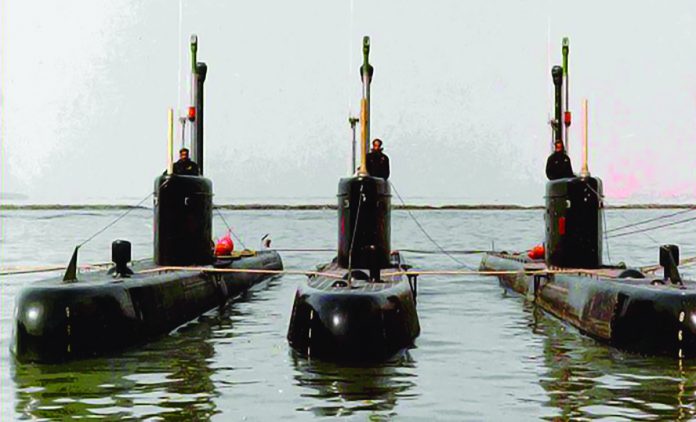Interaction Team
The Cosmos-class submarine, officially designated as Cos.Mo.S MG-110 and locally referred to as X-Craft, is a class of midget submarines that have played a significant role in the Pakistan Navy’s operational strategy. These submarines are notable for their compact size, agility, and suitability for special operations. They have been serving the Pakistan Navy since the early 1990s, primarily as Swimmer Delivery Vehicles (SDVs) for the Navy Special Service Group’s SEAL teams.
Historical background and acquisition
The concept for the Cosmos-class submarines dates back to the early 1980s. Between 1983 and 1985, the Italian firm Cos.Mo.S developed this design for the Italian Navy’s COMSUBIN (Special Forces), which already operated a substantial fleet of midget submarines. These specialized underwater vessels were intended for covert operations, including reconnaissance, sabotage, and insertion of Special Forces.
In 1990, Pakistan entered discussions with the Marina Militare (Italian Navy) regarding the acquisition of the Cosmos-class submarines as replacements for the older SX-404-class submarines purchased from Italy in the 1970s. These discussions culminated in an agreement where Pakistan obtained proprietary designs for the Cosmos-class submarines. Engineers from Cos.Mo.S worked closely with the Karachi Shipyard & Engineering Works (KS&EW) Ltd. to produce the Cosmos-class submarines locally. This collaboration exemplified Pakistan’s growing capacity to manufacture advanced military hardware domestically. The first Cosmos-class submarine was commissioned in 1993, with two additional submarines entering service in the following years.
Design and specifications
The Cosmos-class submarines are designed as diesel-electric midget submarines with a primary focus on special operations capabilities. They are approximately 28 meters (91 ft 10 in) in length, though some sources report a slightly shorter length of 27.25 meters (89 ft 5 in). Their size makes them highly maneuverable and suitable for operations in shallow waters, where larger submarines would face challenges.
The propulsion system consists of a diesel-electric engine driving a single propeller, allowing the submarine to reach speeds of around 6 knots (11.1 km/h) underwater. Its configuration provides a reliable and relatively quiet power source, essential for maintaining stealth during operations. The Cosmos-class has an impressive range of 1,800 miles (2,897 km) when submerged and an endurance of up to 20 days at sea, allowing for prolonged missions without resupply.
In terms of armament, the Cosmos-class submarines are equipped with 533 mm torpedo tubes, capable of launching the Mark 5 torpedo. This armament enhances the submarine’s offensive capabilities, making it suitable for engaging small to medium-sized enemy vessels. The design is notably an improvement over its predecessor, the SX-404-class, in terms of both operational range and weapon systems.
Role and deployment
The primary role of the Cosmos-class submarine within the Pakistan Navy is that of an SDV (Swimmer Delivery Vehicle), used to transport special operations personnel, such as the Navy Special Service Group (SSG) SEAL teams, to their target areas undetected. The midget size and low acoustic signature of these submarines make them ideal for clandestine operations, particularly in coastal and littoral waters where stealth and maneuverability are essential.
Stationed at PNS Iqbal in Karachi, the Cosmos-class submarines have supported Pakistan’s special operations forces in conducting reconnaissance, intelligence gathering, and potentially sabotage missions. They also play a role in coastal defense, providing Pakistan with a deterrent against adversaries in close proximity to its shores.
Initially, the Cosmos-class submarines were under the direct control of the Navy Special Service Group, emphasizing their role in special operations. However, in 2005, operational control was transferred to Commander Submarines (COMSUBS). Later, this control was returned to the Commander of Coastal Areas (COMCOAST), with the Naval Strategic Forces Command overseeing engineering and maintenance.
Strategic significance
The Cosmos-class submarines hold considerable strategic importance for Pakistan. Their ability to operate covertly in shallow waters makes them a valuable asset for asymmetric warfare strategies, where Pakistan’s navy may face technologically superior adversaries. By employing midget submarines, Pakistan can effectively secure its coastal regions, respond to unconventional threats, and exert control over its maritime boundaries.
Moreover, these submarines enhance Pakistan’s maritime special operations capabilities. In conflicts or escalations with neighboring countries, the Cosmos-class could be deployed to disrupt enemy activities, conduct sabotage missions on high-value targets, or insert Special Forces for specific operations. Their existence serves as a psychological deterrent, adding an element of unpredictability to Pakistan’s defensive strategy.
Engineering and maintenance
Another important aspect of the Cosmos-class program is the local manufacturing and maintenance capability developed in collaboration with KS&EW Ltd. By producing and servicing these submarines domestically, Pakistan has gained valuable technical expertise and self-reliance in submarine operations. The Naval Strategic Forces Command manages engineering and maintenance, ensuring that these submarines remain in operational condition and benefit from upgrades when necessary.
Current status and operational history
As of 2019, the Pakistan Navy maintains three active Cosmos-class submarines, which continue to serve in the SDV role for the Navy Special Service Group. While specific operational details are classified, the deployment of these submarines in the Indian Ocean and the Arabian Sea indicates their relevance in maintaining Pakistan’s maritime security. The Cosmos-class submarines have a limited but effective range and endurance, making them suitable for patrolling coastal areas, conducting reconnaissance missions, and ensuring rapid response capabilities. Additionally, they provide Pakistan with a unique edge in low-intensity conflicts, where conventional naval assets may be less effective or appropriate.
Challenges and limitations
While the Cosmos-class submarines serve an essential role, they also face limitations inherent to midget submarines. Their small size restricts operational range, endurance, and payload capacity, making them unsuitable for open-ocean warfare or extended missions far from the coast. Additionally, technological advancements in anti-submarine warfare (ASW) could potentially threaten the effectiveness of midget submarines, as improved sonar and detection systems make it harder to evade enemy forces.
Conclusion
With their compact design, stealth capabilities, and strategic deployment, the Cosmos-class submarines represent a unique asset for Pakistan. While they have limitations, especially in open-sea scenarios, their effectiveness in coastal defense and special operations underlines their importance within Pakistan’s naval doctrine. The Cosmos-class submarines not only add to Pakistan’s defensive options but also contribute to its maritime security and deterrence capabilities, making them an important component of the nation’s military infrastructure.







